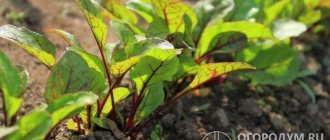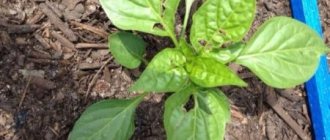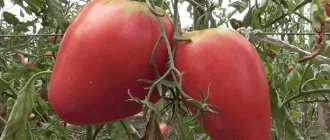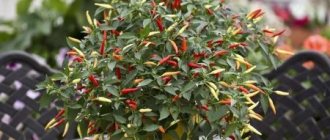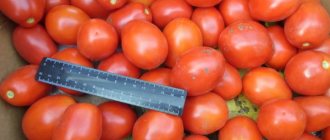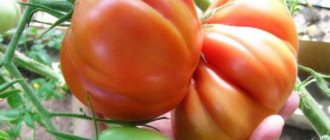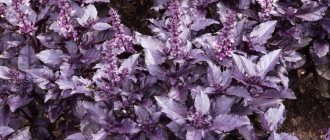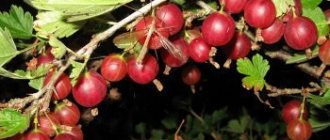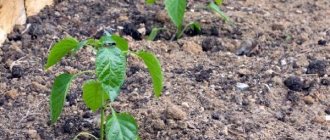The varieties of peppers, both sweet and hot, are striking in their diversity. Domestic gardeners are sometimes even lost at how interesting and original the fruits of this crop can be. At the same time, along with yield indicators, many take into account other characteristics of varieties, for example, the location of fruits on the branches.
Among the popular types of peppers are those whose fruits - cones, prisms or balls - grow upwards rather than downwards. In this review we will tell you about sweet and hot varieties with unusual, upward-pointing fruits.
Review of early cold-resistant varieties
Pepper is a heat-loving crop. Not every variety of fruit will have time to ripen before the onset of cold weather in regions with short summers. Such weather conditions require a cold-resistant vegetable, characterized by low-growing bushes and low maintenance. However, this does not mean that the fruits will differ in taste from their southern counterparts. Breeders have developed many such crops, characterized by compact bushes, resistance to aggressive weather conditions and common diseases.
Czardas
The fruits grown after 100 days fully ripen after 130 days. The compact bush grows to a maximum height of 60 cm. Cone-shaped peppers with a flesh thickness of 6 mm weigh about 220 g. As they ripen, the yellow fruits turn orange with a reddish tint. From 1 m2 you can get up to 10 kg of harvest. Growing is recommended in open beds and in a greenhouse.
cabin boy
Fully mature fruits can be obtained 115 days after germination of the seedlings. The bushes grow small with a maximum height of 70 cm. Cone-shaped peppers with a flesh thickness of 6 mm weigh approximately 180 g. As they ripen, green peppercorns turn red. Growing the crop is recommended under film and in open ground.
Eroshka
The cold-resistant variety brings the first harvest 110–120 days after seedling germination. The low-growing bush grows to a maximum height of 50 cm. Cuboid peppercorns with pulp 5 mm thick weigh about 180 g. As they ripen, the green color changes to orange with a red tint. A high harvest is accompanied by rapid ripening of the fruits. The purpose of the vegetable is universal.
Funtik
The first harvest can be removed from the bush 120 days after germination of the seedlings. A compact bush 70 cm high, densely covered with foliage. As it ripens, the color of the fruit changes from green to red. Cone-shaped peppers with a pulp thickness of 7 mm weigh about 180 g. Growing the crop is recommended in open ground and under film.
Pinocchio F1
The culture brings early harvests 90–100 days after seedling germination. The plant is characterized by an average bush height of up to 70 cm. Cone-shaped fruits with a pulp thickness of 5 mm weigh about 120 g. As they ripen, the walls become red. The culture is characterized by uniform ripening of fruits and resistance to diseases. Vegetables are considered to have a universal purpose.
Chord
The first harvest can be removed from the bush after 110 days after germination of the seedlings. Bushes can grow up to 1 m tall. When ripe, the green walls change color to red. Cone-shaped fruits with a pulp thickness of 6 mm weigh about 190 g. The purpose of the vegetable is universal.
Barguzin
The first harvest is harvested after 110 days, and then it is considered technically ripe. The height of the bushes is about 80 cm. At biological maturity, the green pulp changes color to red. Cone-shaped fruits weighing 200 g have juicy pulp 6 mm thick. The culture adapts well to the local climate.
Tomboy
The crop produces its first harvest 108 days after germination of the seedlings. Green peppercorns with a yellowish tint turn orange when ripe. The weight of the cone-shaped fruits with a rounded tip and a pulp thickness of 7 mm is about 160 g. The plant is distinguished by its friendly fruiting. A bush can bear up to 30 fruits.
Cornet
The harvest can be harvested after 115 days, but for full ripening you must wait 140 days. A mature plant can grow to a maximum height of 1.8 m in a heated greenhouse, with minimal foliage. Prismatic peppers with a flesh thickness of 6 mm weigh about 220 g. As they ripen, the color of the walls of the vegetable changes from green to brown. The culture is recommended for growing in a greenhouse.
Bagration
The harvest can be harvested after 110 days from the moment of planting the seedlings. The plant is characterized by an average bush growth of a maximum height of 80 cm. Ripe peppercorns turn yellow. Cuboid fruits with a pulp thickness of 8 mm weigh about 200 g. The purpose of the vegetable is universal.
Nafanya
Our review of cold-resistant early peppers is completed by the Nafanya variety. The first harvest can be harvested 100 days after germination of the seedlings. The plant is medium tall with a maximum height of 90 cm. Ripened vegetables acquire a red color on the walls. Peppercorns with a pulp thickness of 8 mm weigh about 170 g. The plant is resistant to aggressive weather conditions and many diseases.
The video provides an overview of pepper varieties:
Review of spicy varieties
Let's start with hot peppers, many of which are also grown as an ornamental crop.
Aladdin
Those who see this compact plant, strewn with colorful pods for the first time, do not even believe that it is a hot pepper.
This is exactly the Aladdin variety - beautiful, early, abundantly fruiting and, moreover, very pungent. It surprises not only with its high yield, but also with its magnificent, original appearance.
The bush grows up to 40-50 cm, so the variety is perfect for growing at home: either on a windowsill or on a balcony. The peppers are shaped like small cones, weigh about 20 grams, and grow upward. The color of the fruits is very unusual: at first they can be yellow, cream, pinkish, violet-blue, and only when fully ripe they acquire a red color. The taste of peppers is spicy, but they are very aromatic.
The variety is unpretentious, grows well even in shaded conditions, but still, to obtain a bountiful harvest, it is better to provide Aladdin bushes with light, warmth and moisture.
Falcon beak
The Falcon's Beak hot pepper variety is distinguished by its small size and compactness. Its fruits, directed upward and with pointed cones, truly resemble the beak of a formidable bird. The variety is mid-season, the first hot peppers can be harvested after 120-125 days, but until they are fully ripened, you need to wait about two more weeks.
The pods are elongated, up to 5 cm long, with a burning taste. Each of them weighs only 7-10 grams, but there are a lot of fruits on the bush. The variety is very well suited for drying; the fruits of Falcon's Beak are also used in various marinades.
Bride
The variety of hot pepper with such an original name will amaze with its abundant fruiting. On the bush, which grows only 30 cm in height, a large number of small, very fragrant pods are formed.
The variety is mid-season, grows well in greenhouses, and is also very often grown as an ornamental plant on the balcony or in the kitchen. The fruits are pods, grow upward, at first have a delicate cream color, then the skin becomes orange and then bright red. At one time, fruits of different colors can grow on the bush, and such a plant looks very elegant.
Fruiting is abundant and long lasting. The taste of the fruit is spicy, with a piquant spicy note.
Fire Volcano
For those who prefer unusual varieties, we recommend paying attention to the fiery Volcano pepper. During fruiting, the bush really looks very much like an erupting volcano, since its reddening fruits are directed upward. The variety is early, which is very suitable for gardeners in the northern regions. The first fruits are ready for harvest after 90 days; they can be picked green.
The pods are elongated, cone-shaped, reaching approximately 10 cm in length, weighing up to 15-19 grams. The walls are thin, up to one and a half millimeters, so this pepper is suitable for drying. The taste of peppercorns is hot and there is a specific aroma.
Queen of Spades
This variety of hot pepper is best grown at home or on the balcony, especially since it is very decorative. The bush has a round shape, its height is no more than thirty centimeters. The interesting fruits of the Queen of Spades are tiny cone-shaped peppers that are purple at first and then turn orange.
At the same time, there may be peppers of different colors on the bush, so during the fruiting period the plant looks like an exotic flower. This variety of peppers has a fiery taste and is very aromatic. They are used as a seasoning for soups, side dishes, and can also be added to marinades and preserves.
Constellation
This variety is characterized by extended fruiting, while the peppers ripen early. The bush is very low, well leafy. The fruits grow one at a time in the axil, directed upward. The shape of the peppers is similar to tiny hearts - pot-bellied, weighing no more than 9-10 grams.
It is no coincidence that the variety is named Constellation, since its fruits in different phases of ripening have different colors: purple, orange, yellow, bright lilac, red. It gives the impression of a real bright constellation – shimmering and multi-colored.
You may be interested in: Favorable days for planting pepper for seedlings in 2022: terms and rules for sowing at home Favorable days for picking pepper in 2022 according to the lunar calendar Favorable days for sowing sweet and bitter pepper for seedlings in 2022
The fruits have relatively thick walls - up to 2 mm, suitable for drying and adding as a spice to all dishes. They are also used in marinades and various preparations to add a spicy taste.
Rowanushka
Of course, this pepper bears little resemblance to real rowan, but there is still a vague resemblance. The variety is mid-early, the fruits are round, located on the tops of the branches and directed upward. The color of the skin of the round pods varies from purple to dark orange, which gives the compact bush a very bright appearance.
Peppercorns are small in weight, up to 5 grams, but taste very hot, with a pleasant spicy aroma. It is recommended for cultivation as a potted crop, although many people use this pepper to decorate flower beds. The fruits are very suitable for making paprika; they are used as a component of various hot seasonings, sauces, ketchups, and also for marinades.
Figure
The decorative variety Figure is perfect for growing at home and on the balcony. The plant is compact, medium leafy. Produces a large number of small fruit pods of bright red color.
Features of the variety: yield, fruit location (peppers grow upward). The fruits are very hot and aromatic. Suitable for any type of processing, for drying, adding to dishes as a spice.
Carmen
A low bush of the Carmen variety will decorate a loggia, veranda, and kitchen. The plant reaches only 30 cm in height, there are many leaves, as well as fruits. The peppers stick up all over the bush, at first they are green, then gradually turn red.
The plant has a beautiful rounded crown, and the bright fruits give it a special flavor. The pods are sharp, with a spicy aroma, and weigh no more than 10-12 grams. Value of the variety: unpretentiousness, friendly fruiting, shade tolerance.
Gorgon
Another bitter pepper with fruits that grow upwards rather than downwards is Gorgon. It grows well in garden beds, but it is still better to grow it under cover. The plant is small in height, up to half a meter, so it can be planted under arches or in tunnels under film.
The fruits are small, up to 2 grams in weight, conical cones pointing upward. At first they have a rich green color, then change it to bright red. This means that the fruits have reached full maturity, although they can also be eaten green.
Conditions for growing sweet peppers in open ground
From the moment the first shoots appear in pepper crops until the fruits ripen, a fairly long period passes: on average, 110-125 days. Provided that all this time the temperature should be about +20 degrees, in some Russian regions summer residents understand that this is impossible. Such a long summer is found only in the south; moreover, the pepper crop is extremely demanding on the abundance of sunlight.
Important! The optimal temperature for growing sweet peppers is +26-30 degrees. Some varieties stop developing if it gets colder than +15 outside.
. However, there is a way out of the situation
The process of growing peppers is divided into three separate stages:
However, there is a way out of the situation. The process of growing peppers is divided into three separate stages:
- selection and sowing of seeds;
- growing seedlings at home;
- planting seedlings in open ground.
This method is called “seedling” and is appropriate both in central Russia and in the south. Now let's move directly to the varieties of sweet peppers with a thick wall.
Pepper - features of care, planting and growing
There are more than 2,000 species of peppers in nature, and their homeland is Central America. In this article I will talk about sweet peppers, also called bell peppers. The “Mexican” came to Europe in the 15th century and, in a roundabout way, through Spain, Turkey, Iran, eventually entered our region. Here it has seriously taken root, despite its heat-loving nature and capricious disposition - after all, pepper has more than enough merits! It is not only rich in bright colors that give the dish a festive look, it is not only tasty and juicy, but it is also an invaluable storehouse of vitamins. In this regard, a rare vegetable or fruit can be compared with it.
But to get a good harvest, you will have to try. This “southerner” loves warm weather, so in mid-latitudes it is grown mostly by seedlings and in greenhouses.
Pepper is a short-day plant, that is, if daylight hours last less than 12 hours, pepper begins to bear fruit earlier and, importantly, produces more stable and higher yields.
Growing pepper seedlings
If you do not have a greenhouse, then pepper seeds must be sown in February so that the plants are 90-100 days old before transplanting in May.
Pepper does not tolerate picking well, so try to immediately sow the seeds in individual peat pots with a diameter of about 8-10 cm. It makes no sense to use large pots due to the slow development of the pepper root system.
The substrate for growing pepper seedlings should be light and loose and consist of 2 parts humus mixed with 1 part sand and 1 part soil. For 1 kg of this mixture you need to add a tablespoon of ash.
Pepper seeds require pre-planting treatment - they need to be kept until they swell, for five hours, in water at a temperature of about 50 °C. After this, they must be placed in a damp cloth for pecking for 2-3 days, the room temperature is about 20 ° C. By carrying out this simple pre-planting preparation of pepper seeds, you will get seedlings literally the next day after sowing.
The sown pepper seeds must be thoroughly watered and immediately after that covered with plastic wrap or glass. Before emergence, they can be in any warm (about 22°C) place, the lighting does not matter, it is possible in the dark.
After emergence, the optimal temperature for growing pepper seedlings is about 26-28 °C during the day, and about 10-15 °C at night. You should not pamper pepper seedlings with excessive watering, this can only harm it and cause blackleg disease. But try not to let the substrate dry out. The water for watering pepper seedlings should be warm - about 30 ° C; if it is too cold, the seedlings will become frail, get sick and may even die. Do not forget to monitor the air in the room in which the seedlings are grown; it should not be too dry. Spray the plants, and ventilate the room itself thoroughly, remembering to protect the plants from drafts.
Pepper seedlings require additional lighting, so during the month of February they need to be illuminated from 7 a.m. to 9 p.m.
Before planting, seedlings need to be hardened, gradually accustomed to the rays of the sun, lower temperatures, wind and rain. To do this, the plant is taken out into the fresh air, gradually increasing the time it stays there. During hardening, monitor the weather conditions; pepper seedlings should not be allowed to be exposed to frost or low temperatures - for pepper this is below 13 °C.
Planting pepper
The best predecessors for peppers: onions, cucumbers, pumpkin, cabbage after green manure, zucchini and carrots. Bad predecessors for peppers: potatoes, peppers, tomatoes, physalis and eggplant.
Light soils are best for growing peppers. It is better to prepare the soil for peppers in advance - a year in advance, adding 5 kg of organic fertilizers per square meter to the predecessor of the pepper. meter, and in the fall 50 g of potash and phosphorus fertilizers for deep digging. In the spring, add 40 g of ammonium nitrate to the top layer of soil. Five days before transplanting pepper seedlings to a permanent place, start disinfecting the soil; this must be done using a solution - add a tablespoon of copper sulfate to a bucket of water.
Pepper seedlings are planted in open ground at the end of May - mid-June, according to a 40x40 cm pattern. Pepper seedlings are planted in an unheated film greenhouse in early April, and in tunnel shelters at the end of May.
Try to place the seedlings in the holes at the same depth at which the plants grew in the seedling box, without exposing the roots of the pepper and without digging in its root neck. Pepper does not like cold soil, and if you want to get a serious harvest, arrange high beds for it, which must be raised by 25-55 centimeters.
Remember, peppers are highly susceptible to cross-pollination, so if you plant several varieties of peppers on your plot, try to place them as far apart as possible and, if possible, separate them from each other by planting tall tomatoes, corn and sunflowers.
Growing pepper by planting seeds in open ground is not practical even in the southern regions. You will still have to sow late, when the soil warms up, the plant will develop more slowly, the first fruits will ripen later, and the fruiting period of the pepper will be significantly shorter.
Pepper care
Pepper care consists of timely watering, gartering, weeding and fertilizing. The first feeding of pepper seedlings must be carried out in the phase of 1-2 true leaves, for which 0.5 g of ammonium nitrate, 1 g of potassium fertilizer and 3 g of superphosphate are mixed in 1 liter of water. The second feeding is 2 weeks after the first; the dose of mineral fertilizers for it must be doubled.
It is effective to feed pepper seedlings with a special infusion of nettle, for the preparation of which you need to take 1 part of nettle and 10 parts of water - leave for 2 days. The last feeding should be done 2 days before you intend to plant the seedlings in a permanent place, while increasing the dose of potassium fertilizers to 7 g per 1 liter of water. During the season, you need to fertilize the pepper about 3-4 times with chicken manure - 1:10, alternating such fertilizing with foliar fertilizing, for which you need to use mineral fertilizers, for example nitrophoska (a tablespoon per bucket of water).
With a lack of potassium, the pepper leaves curl and a drying border appears on them. But you need to be careful with potassium - pepper does not tolerate an abundance of potassium chloride. If a plant lacks nitrogen, its leaves become dull and, acquiring a grayish tint, gradually become smaller. When there is a lack of phosphorus, the underside of pepper leaves turns deep purple, and the leaves themselves are pressed closer to the plant trunk and rise up. If there is a lack of magnesium, the leaves become marbled in color, and excess nitrogen in the soil leads to the dropping of the ovaries and flowers of the pepper.
In hot and humid weather, it is necessary to carry out pinching (removing side shoots), especially for the lower stepsons, and vice versa, if the weather is hot but dry, the plants do not pinion, since the leaf mass perfectly protects soil moisture from evaporation. Experienced vegetable growers advise removing the central flower on the plant, growing from the first branch, this will help increase the yield.
During the growing season, peppers need to be pruned several times, trying to shorten the longest shoots and ensure that there are no shaded branches. Be sure to remove all pepper shoots below the main fork of its stem, as well as branches inside the crown. Pruning must be done once every ten days and after harvesting the fruits. Simultaneously with pruning, soil cultivation is also carried out.
Try to attract pollinating insects to the garden; to do this, during flowering, spray the plants with a sugar solution: 100 g of sugar and 2 g of boric acid per liter of hot water. Feeding peppers with liquid organic fertilizers gives excellent results.
It is useful to mulch peppers with rotted straw - a layer of about 10 cm, thanks to which you can reduce the frequency of watering, reducing them to once every 9-10 days.
Timely care of pepper plants also includes staking the plants. It is necessary to make a garter after hilling and mulching.
Pests and diseases of pepper
The most common diseases of pepper: late blight, white rot, macrosporiosis, blossom end rot, septoria, blackleg. The most harmful to peppers are slugs, whiteflies, cutworms, aphids, Colorado potato beetles and mole crickets. To protect the pepper from damage by the mole cricket, an hour before planting its seedlings, the pre-made holes must be filled with water. After planting the pepper seedlings, spray the plantings again with a sprayer. Pepper plants need to be pollinated 3 times per season using wood ash - preferably with dew. This will also help protect them from pests.
If you notice aphids on pepper seedlings, treat the pepper with serum - one and a half liters per bucket of water. After this procedure, powder the plants with sifted wood ash.
Pepper varieties
Before planting peppers, you need to decide on the choice of variety, and here everything depends not only on your taste preferences, but also on the purpose of the future fruits. So, if you intend to consume peppers mainly fresh, it is better to give preference to thicker-walled and large-fruited varieties, such as California Miracle, Gladiator, Winnie the Pooh or Gift of Moldova. If the main purpose is preservation, then choose small-fruited varieties belonging to the “Siberian” series: Kupets, Ermak, Victoria, etc.
Ermak is one of the fastest ripening varieties of pepper; the fruits ripen early and smoothly. After the first harvest, the Ermak pepper variety blooms again and gives a good second harvest. Very large fruits, the weight of which reaches 250 g. The yield of the variety is 12-15 kg/sq. m.
Gladiator is a mid-late Dutch variety with large, bright yellow, tasty, thick-fleshed fruits. The thickness of the fruit walls reaches 13 mm, the weight of individual specimens reaches 380-400 g, and the yield is 10-12 kg/sq. m.
Medal is an early ripening variety characterized by extended fruiting. It constantly blooms and forms new ovaries. The fruits of the Medal variety are quite large - up to 150 g, in biological ripeness they are bright red in color, with a wall thickness of about 8-13 mm. The yield of the variety reaches 16 kg/sq.m. m.
Yova is one of the fastest ripening Russian varieties, from the emergence of shoots to the moment of technical ripeness, about 95-100 days pass. Very productive, juicy and thick-walled. The yield is up to 14 kg per m2, and the weight of some of its fruits exceeds 250 g. It is unpretentious and gives excellent yields even on heavy soils.
California miracle is a mid-early variety, fruit weight up to 400 g, and wall thickness up to 12 mm.
Black cardinal - belongs to the late Italian varieties, has unusually beautiful black-purple fruits (in technical ripeness) turning into red (in biological ripeness). From 1 sq. m up to 10 kg of harvest.
Victoria is a mid-early variety, the fruits are relatively small in weight - up to 110 g, cone-shaped, slightly ribbed, about 7-13 cm long, wall thickness 7-8 mm. Productivity 9-10 kg/sq. m.
Marina, Nekrasovskoe
Tanya, thank you for the detailed story about this wonderful culture! But I don’t agree that pepper doesn’t tolerate pickling well, even though they write about it everywhere! My plant survival rate after picking is 100%, no problems. By the way, I bury them, contrary to all recommendations; if the seedlings have stretched out a little - up to the very cotyledon leaves. Excellent, strong plants are obtained and bear fruit in the conditions of the Middle Zone in open ground. And as for the planting scheme, experience (not only mine, but also that of my gardening friends) suggests that peppers prefer dense planting; they bear fruit better in crowded conditions. Well, not literally, of course - they still need room for development. But 40 cm is a lot!
These are, of course, just my observations. I know that many people grow them exactly according to the recommendations, and their peppers also bear fruit well. But still I can’t help but share :))
And of the varieties, I have two favorites: Black Horse and Marconi. I also plant others, but I just love these ones for their unusualness.
The black horse gives a good harvest, begins to bear fruit early and looks original on the bush. And Marconi has very long, thin-walled fruits. For some reason I really like their taste, although there is not much pulp there.
Lyudmila Shuban, Karaganda
She was looking for a Black Horse and a Black Cardinal from us! Have not found yet! But I took Big Papa and another black and purple variety, I don’t remember the name! Maybe they’ll bring more black ones, I’m waiting!
Tatiana
Thank you Marina for sharing your secrets.)) This year I’ll try to compact some of the plantings a little and compare the results - maybe they will bear fruit even better for me, although everything is fine as it is))
As for the survival rate after picking, it’s true that my peppers don’t take root well - at first they wither, then they barely move away, but steadily, they get sick for two weeks and, as a result, lag behind in development ((But peppers planted immediately in peat cups feel great immediately after transplants begin to bear fruit earlier and produce more stable yields.))
Your peppers are very beautiful Marina. :) I also plant a black horse, I also respect it for its early fruiting and originality - it’s too beautiful. But I have never planted Marconi - I have to try it.) My favorite variety of pepper is probably Gladiator - it simply amazes with its fruits, they are not only much larger than other varieties, but also very, very tasty.)))
Marina, Nekrasovskoe
Tanya, it is quite possible that with picking it’s all about the age of the seedlings, although this is also not a fact: usually I pick in the cotyledon phase, but it happened later. This year my friend picked peppers with the first pair of true leaves; I saw these peppers: they didn’t even notice the transplant)) In fact, sometimes it’s difficult to even understand why the same action brings different results, you just have to state the fact

